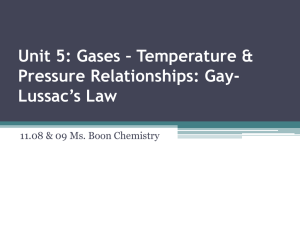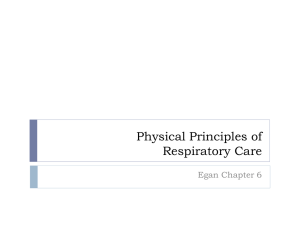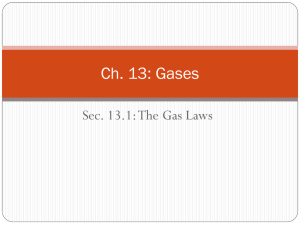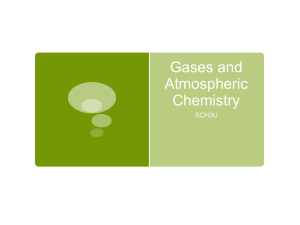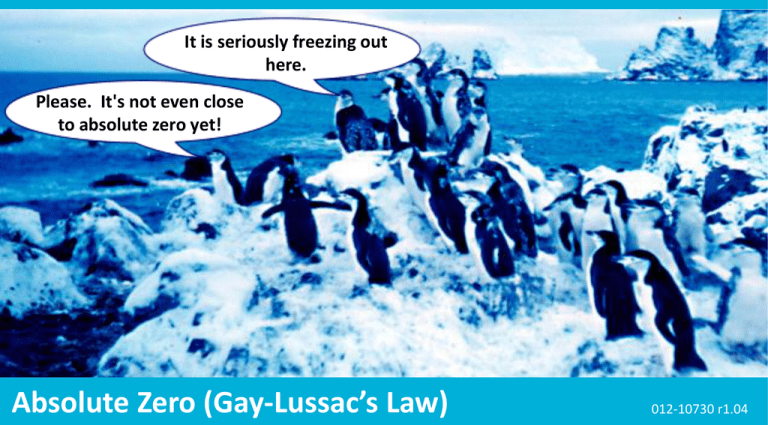
It is seriously freezing out
here.
Please. It's not even close
to absolute zero yet!
Absolute Zero (Gay-Lussac’s Law)
012-10730 r1.04
Absolute Zero (Gay-Lussac’s Law)
Introduction
Journals and Snapshots
The Snapshot button is used to capture the
screen.
The Journal is where snapshots are stored
and viewed.
The Share button is used to export
or print your journal to turn in your
work.
Each page of this lab that
contains the symbol
should be inserted into your
journal. After completing a
lab page with the snapshot
symbol, tap
(in the upper
right hand corner) to insert
the page into your journal.
Note: You may want to take a
snapshot of the first page of
this lab as a cover page for
your Journal.
Absolute Zero (Gay-Lussac’s Law)
Lab Challenge
Temperature is a measure of the average kinetic energy (motion) of molecules. As
the temperature of something drops, the motion slows down. Things can’t move
slower than stopped. Does this mean there is a lowest possible temperature and if
so, what is this temperature?
Cold air
Hot air
molecules
move fast!
molecules move
slowly.
What happens
when air
molecules are
very, very, very,
very, very, very,
very cold???
Absolute Zero (Gay-Lussac’s Law)
Background
• Gas molecules move through space, bumping into things. This causes air
pressure. The more collisions there are each second, the more pressure
there is.
• Temperature is the average kinetic energy (speed) of the particles
in a sample.
Absolute Zero (Gay-Lussac’s Law)
Self-Check
1. Pressure is caused by the collision of gas
molecules with ______________.
a) higher volume
b) liquid molecules
c) the walls of the container
d) motion
e) excessive homework
Absolute Zero (Gay-Lussac’s Law)
...Background
• Kinetic energy is related to the speed of the molecules, so if the
temperature increases, the molecules move faster.
• An increase in speed will cause gas molecules to strike the walls of
the container more times per second, so the pressure increases.
• The direct relationship between pressure P and temperature T was
discovered by Joseph Gay-Lussac in 1802. Gay-Lussac's law is
expressed mathematically as:
P
T
k
(constant)
OR
P1
T1
P2
T2
Absolute Zero (Gay-Lussac’s Law)
Self-Check
2. If you decrease the temperature of a gas inside a
container, what happens to the gas particles?
a) They exert higher pressure.
b) They increase in kinetic energy.
c) They decrease in speed.
d) They increase in speed.
Absolute Zero (Gay-Lussac’s Law)
...Background
• If it were possible to continue to remove kinetic energy by cooling, there
should come a point where the gas particles would be so cold they would
have no kinetic energy at all!
• If particles have zero kinetic energy, they are no longer moving and,
therefore, are not able to collide with the walls of the container to create
pressure.
• This theoretical point at which kinetic energy has been completely removed
from a system (particles stop moving and the pressure equals zero) is known
as absolute zero.
Absolute Zero (Gay-Lussac’s Law)
...Background
• Because temperature is a
measurement of
molecular motion (kinetic
energy), the Kelvin
temperature scale sets
the point of no kinetic
energy as its starting
point, 0 K.
• This means that the
Kelvin scale has no
negative values.
Boiling point of water
Weather: highest temp.
recorded in the world
Freezing point of water
Weather: lowest temp.
recorded in the world
Moon at its coldest
Absolute zero
Absolute Zero (Gay-Lussac’s Law)
Self-Check
3. The Kelvin temperature scale is based on
___________________.
a) molecular motion
b) the freezing point of water
c) the boiling point of water
d) the coldest temperature ever recorded
Absolute Zero (Gay-Lussac’s Law)
...Background
• Absolute zero can be calculated experimentally using Gay-Lussac's law to find
the relationship between pressure and temperature. The relationship can then
be used to calculate temperature (absolute zero) when the pressure equals zero.
• Gay-Lussac's law can be rearranged to give the familiar equation of a straight
line:
P
T
k
P kT
y
mx
• There is one small catch, Gay-Lussac’s law requires that the temperature
measurements be in Kelvin.
Absolute Zero (Gay-Lussac’s Law)
Self-Check
4. When using Gay-Lussac's law, the value for
temperature must always be measured in ______.
a) ˚F
b) kPa
c) ˚C
d) K
P
T
k
Absolute Zero (Gay-Lussac’s Law)
Safety
• Follow all common laboratory procedures.
• Be careful with hot water! Water at 65˚C (149˚F) has enough kinetic
energy to damage skin and eyes.
HOT!!
Absolute Zero (Gay-Lussac’s Law)
Materials and Equipment
Collect all of these materials before beginning the lab.
• Sensor extension cable
• Absolute pressure sensor
• Quick-release connector
• Tubing connector
• Fast response temperature sensor
• Tubing, 1- to 2-cm
• Test tube, 15-mm x 100-mm
• One-hole stopper for test tube
• Beakers (2), 250-mL
Absolute Zero (Gay-Lussac’s Law)
Materials and Equipment
Also collect these additional materials before starting.
•
•
•
•
•
•
•
•
•
•
Polystyrene cups (2)
Rubber band
Ring stand
Three-finger clamp
Crushed ice (300 mL)
Room temperature water, 300 mL
~45˚C water, 300 mL
~55˚C water, 300 mL
~65˚C water, 300 mL
Glycerin, 2 drops
Glycerin
Absolute Zero (Gay-Lussac’s Law)
Sequencing Challenge
A. Place the closed
test tube in a
polystyrene cup
containing ice-water
and record the
pressure and
temperature.
B. Set up the
equipment to
measure pressure
and temperature of
air trapped in a test
tube.
C. Graph the data and
use the equation of
the line of best fit to
determine absolute
zero.
D. Replace the icewater with water at
25 ˚C, 45 ˚C,
55 ˚C, and 65 ˚C.
Record the pressure
and temperature for
each.
The steps to the left are part
of the procedure for this lab
activity. They are not in the
right order. Determine the
correct sequence of the
steps, then take a snapshot
of this page.
Absolute Zero (Gay-Lussac’s Law)
Prediction
Q1: What will happen to the
pressure in the test tube
as temperature
increases? Draw your
prediction on the graph
provided.*
*To Draw a Prediction:
1. Tap
to open the tool
palette.
2. Tap
then use your finger
to draw your prediction.
3. Tap
when finished.
4. If you make a mistake, tap
to clear your
prediction.
Absolute Zero (Gay-Lussac’s Law)
Setup
1. Connect the fast response temperature sensor to the data collection
system.
2. Connect the absolute pressure sensor to the data collection system using
a sensor extension cable.
Pressure sensor
Extension cable
Absolute Zero (Gay-Lussac’s Law)
Setup
3. Connect the quick-release connector to the
stopper using the tubing connector and the
1- to 2-cm piece of tubing. Put a drop of glycerin
on the connectors as necessary.
Tubing connector
Stopper
Quick-release
connector
Tubing
Q2: Temperature and
pressure are being
measured for what
substance during this
experiment?
Absolute Zero (Gay-Lussac’s Law)
Setup
4. Use a rubber band to attach the quickresponse temperature sensor to the
outside of the test tube. The sensor should
be about halfway down the test tube.
5. Use a rubber band to attach
the quick-response
temperature sensor to the
outside of the test tube. The
sensor should be about
halfway down the test tube.
Temperature sensor
Rubber band
Q3:The temperature
sensor is placed on the
outside of the test
tube. Is this a problem?
Explain.
Absolute Zero (Gay-Lussac’s Law)
Setup
6. Attach a three-finger clamp to a ring
stand. Use the three-finger clamp to
securely hold the absolute pressure
sensor in a vertical position.
7. Place the polystyrene cup into a
250-mL beaker. Fill the polystyrene
cup to the top with ice. Add water
to make an ice bath.
Q4: Why is a polystyrene
cup used instead of
just a beaker?
Absolute Zero (Gay-Lussac’s Law)
Setup
Q5a: What is the dependent variable (with units) in this experiment?
Q5b: What is the independent variable (with units) in this experiment?
Absolute Zero (Gay-Lussac’s Law)
Setup
8. Place the beaker containing the
polystyrene cup and ice-water
underneath the absolute
pressure/test tube apparatus and
slowly lower the test tube into the
ice-water.
9. Angle the test tube in the cup so
the entire test tube is covered
with the ice-water. Place more ice
on top of the test tube to ensure
that the entire test tube is
covered with ice.
Q6: Why is it necessary for
the entire test tube to
be covered with the
ice-water?
Absolute Zero (Gay-Lussac’s Law)
Procedure
1. Tap
to start a new
data set.
2. Wait ~2 minutes to allow
the temperature of the
air in the test tube to
become the same
temperature as the ice
water surrounding it.
3. Tap
to record the
temperature (in ˚C and K)
and pressure.
4. Remove the test tube
from the ice water bath.
Absolute Zero (Gay-Lussac’s Law)
Procedure
5. Place the second
polystyrene cup into the
second 250-mL beaker.
6. Fill the polystyrene cup
with water at room
temperature (~25˚C).
7. Angle the test tube in the
cup so it is covered with
water.
8. Wait ~ 2 minutes.
9. Tap
to record the
temperature and
pressure.
Absolute Zero (Gay-Lussac’s Law)
Procedure
10. Collect three more data
points by replacing the
room temperature water
with water at:
~ 45 ˚C
~ 55 ˚C
~ 65 ˚C
11. For each sample wait ~ 2
minutes and then tap
to record the temperature
and pressure.
12. When all five data points
have been collected, tap
to stop the data set.
Absolute Zero (Gay-Lussac’s Law)
Data Analysis
1. Using the data collected,
derive the mathematical
equation used to convert
between the Celsius and
Kelvin temperature scales.
Absolute Zero (Gay-Lussac’s Law)
Data Analysis
2. Create a best fit line (linear
fit) of data using the ˚C
values for T.*
Note: the equation of the best
fit line gives:
P = kT
(y = mx )
*To Apply a Curve Fit:
1. Tap
to open the tool
palette.
2. Tap
to open the Curve
Fit screen.
3. Tap the name of the curve
fit required.
Absolute Zero (Gay-Lussac’s Law)
Data Analysis
3. Use the equation of the best fit line to solve for absolute zero in units of ˚C. Show
your work.
Hint: Absolute zero is the temperature when pressure equals zero.
Absolute Zero (Gay-Lussac’s Law)
Data Analysis
4. Calculate the percent error of your experimental value of absolute zero (the
accepted value of absolute zero is -273.15˚C). Show your work.
percent error =
(accepted value - experimental value)
accepted value
x 100
Absolute Zero (Gay-Lussac’s Law)
Data Analysis
5. Determine the constant k
for the five data points
collected using Kelvin
temperatures. Enter the
constants into the table.*
P
k
T
*To Enter Data into a Table:
1. Tap
to open the tool
palette.
2. Tap
then tap a cell in
the data table to highlight
it in yellow.
3. Tap
to open the
Keyboard screen.
Absolute Zero (Gay-Lussac’s Law)
Data Analysis
6. Determine the constant k
for the five data points
collected using ˚C
temperatures. Enter the
constants into the table.*
P
k
T
*To Enter Data into a Table:
1. Tap
to open the tool
palette.
2. Tap
then tap a cell in
the data table to highlight
it in yellow.
3. Tap
to open the
Keyboard screen.
Absolute Zero (Gay-Lussac’s Law)
Analysis
1. Was pressure divided by 2. Was pressure divided by
temperature a constant
temperature a constant
when using temperature
when using temperature
values measured in K?
values measured in ˚C?
Why or why not?
Why or why not?
3. Are pressure and
temperature directly or
indirectly proportional?
How do you know?
Absolute Zero (Gay-Lussac’s Law)
Analysis
4a. What is the Kelvin temperature scale
based on?
4b. What is special about 0 K?
Absolute Zero (Gay-Lussac’s Law)
Analysis
5. Calculate the pressure of the air inside the test tube if it were warmed to
100.0 °C. Show your work (there are several steps)!
Absolute Zero (Gay-Lussac’s Law)
Synthesis
1. Another lab group did the same
experiment using a syringe instead of a
test tube. Could this cause a problem?
Explain.
Absolute Zero (Gay-Lussac’s Law)
Synthesis
2. Explain why an over-inflated tire may pop when it is
driven fast on a hot day.
Absolute Zero (Gay-Lussac’s Law)
Multiple Choice
1. Which of the following graphs best represents the
relationship between the pressure of a gas and
Kelvin temperature?
A)
B)
C)
D)
Absolute Zero (Gay-Lussac’s Law)
Multiple Choice
2. Why does pressure become zero at a
temperature of absolute zero?
a) At absolute zero all molecular motion stops.
b) At absolute zero there is a complete vacuum.
c) At absolute zero the gas volume is very
small.
d) At absolute zero all the energy of the gas is
given off as light.
Absolute Zero (Gay-Lussac’s Law)
Multiple Choice
3. What is the equivalent of 413 K in Celsius?
a)
-273˚C
b)
0˚C
c)
140˚C
d)
696˚C
e)
237 K
Absolute Zero (Gay-Lussac’s Law)
Multiple Choice
4. If a container of gas is at a temperature of 27 ˚C
and a pressure of 800 torr, what would the
pressure of the gas become if the temperature
were doubled to 54˚C?
a) 1600 torr
b) 400 torr
c) 872 torr
d) 734 torr
Absolute Zero (Gay-Lussac’s Law)
Multiple Choice
5. If the temperature of a gas in a closed, rigid
container decreases, the pressure inside this
container will _________________.
a) increase
b) decrease
c) stay the same
d) Either A or B depending on the type of gas.
Absolute Zero (Gay-Lussac’s Law)
Congratulations!
You have completed the lab.
Please remember to follow your teacher's instructions for cleaning-up and submitting
your lab.
Absolute Zero (Gay-Lussac’s Law)
References
All images were taken from PASCO documentation, public domain clip art, or Wikimedia Foundation Commons.
1.PENGUINS http://www.openstockphotography.org/imagelicensing/penguins/Adelie_penguins_at_Cape_Geddes_Laurie_Island_1962.jpg
2.THERMOMETER http://www.freeclipartnow.com/science/thermometer-big.jpg.html
3.FLAMES http://www.freeclipartnow.com/science/energy/Flames-1.jpg.html
4.ICICLE http://www.freeclipartnow.com/nature/weather/icicles.jpg.html
5.SNOW FLAKE http://www.freeclipartnow.com/nature/weather/snow/snow-flake-shadowed.jpg.html
6.STOP SIGN http://www.freeclipartnow.com/small-icons/miscellaneous/stop-sign.jpg.html
7.WEATHER http://commons.wikimedia.org/wiki/File:Mistral_wind1.jpg
8.BALLOONS http://www.freeclipartnow.com/recreation/partying/balloons-01.jpg.html
9.HOT WARNING http://commons.wikimedia.org/wiki/File:DIN_4844-2_Warnung_vor_heisser_Oberflaeche_DW026.svg
10.EYE WASH http://commons.wikimedia.org/wiki/File:Sign_eyewash.svg
11.BEAKER http://www.freeclipartnow.com/science/flasks-tubes/beaker-2.jpg.html
12.CRUSHED ICE http://commons.wikimedia.org/wiki/File:Hail_001.JPG
13.GLASS OF WATER http://www.freeclipartnow.com/food/beverages/glass-of-water.jpg.html
14.CALCULATOR http://www.freeclipartnow.com/education/supplies/simple-calculator-01.jpg.html
15.TWO GAS CYLINDERS
http://commons.wikimedia.org/wiki/File:Compressed_gas_cylinders.mapp_and_oxygen.triddle.jpg



